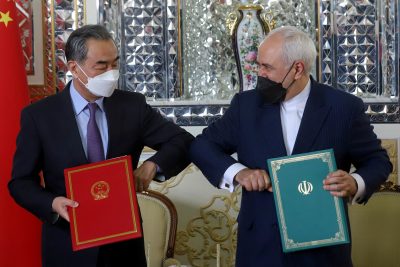China
Is China angling for a Saudi–Iranian detente?

Author: Guy Burton, Brussels School of Governance
China’s Foreign Minister Wang Yi embarked on a six-country tour of the Middle East at the end of March 2021. On the eve of his departure, Wang announced China’s five-point plan for the region, which included mutual respect, equity and justice, non-proliferation, collective security and development cooperation.
The principles set out in the five-point plan are uncontentious — and it is also not the first time that China has issued a plan for the Middle East. In 2013, Chinese President Xi Jinping launched a four-point plan around the Israel–Palestine conflict. Four years later he re-launched it, this time referencing China’s Belt and Road Initiative — with Israel and Palestine as important partners.
What makes the recent five-point plan unique is its wider scope to include other conflicts in Syria, Libya and Yemen, as well as the rivalries in the Gulf. In a departure from previous proposals, Wang also set out some concrete suggestions for how tensions in the Gulf might be managed. They included China hosting a ‘multilateral dialogue conference’ to help create a trust-building mechanism which — as a first step — could ensure the ‘safety of oil facilities and shipping lanes’.
In the end, the five-point might not make much of a splash. There was no statement on when the conference might happen or what role Beijing would have in the design or guarantee of the trust-based mechanism. The plan was also overshadowed by the media coverage given to an alleged 25-year cooperation deal signed between China and Iran — which some observers have argued is overstated.
Yet even if the five-point plan seems like it may fizzle out, its spirit kept with regional developments in the past month. Saudi and Iranian officials met at a face-to-face meeting in Baghdad for the first time since diplomatic relations broke off five years ago. Initially, the Saudis denied the meeting took place. But at the end of April, Crown Prince Mohammed bin Salman (MBS) implicitly backed the move. In a television interview, he abandoned his previous confrontational language towards Iran in favour of a more conciliatory tone, expressing his hope for ‘good’ relations.
In explaining the shift, analysts have focused on changes taking place in the United States, in particular the presidency of Joe Biden. Not only was Trump more sympathetic towards MBS than Biden, but he also pursued a ‘maximum pressure’ strategy against Iran when he pulled the United States out of the Joint Comprehensive Plan of Action (JCPOA) and reimposed sanctions. In contrast, Biden is perceived as cooler towards MBS. His administration is pushing back on Saudi Arabia’s military campaign in Yemen and is also involved in indirect talks with Iran over the future of the JCPOA.
But focusing on US-centric explanations is too limited given the increasing multipolarity of the Middle East. A quiet Chinese word may have also made a difference. For instance, official statements made clear that Wang was likely to have some frank discussions around ‘peace in the Middle East’ during his trip to the region.
China has sufficient base and motivations to have such conversations.
First, Saudi Arabia and Iran are among the most important countries for Chinese commercial activity in the Middle East. Besides the oil trade, Saudi Arabia and Iran are the largest and third largest recipients of Chinese capital respectively in the region. So, instability in the region, including from the Iran–Saudi Arabia rivalry, would adversely affect China’s business interests.
Second, China has the means to engage with Riyadh and Tehran on a substantive basis. China’s stated commitment to non-interference gives it the air of an honest broker. The two countries have also been elevated to the same level of importance — in 2016 China signed comprehensive strategic partnerships with both Iran and Saudi Arabia. This is the highest form of diplomatic recognition and cooperation it can bestow short of a formal alliance. Such partnerships seek to expand ties beyond the economic sphere to include political interaction and exchange at different levels.
A Chinese word would not be ignored. For the Saudis, Biden’s approach is narrowing the gap between US and Chinese positions in the Gulf. For the Iran, its geopolitics has become heavily weighted towards China and Beijing has shown that it is prepared to leverage this, for example by previously persuading Iran to accept the JCPOA.
But while China has some advantages over the United…
China
China’s November 2024 Economy: Navigating Mixed Signals and Ongoing Challenges

In November 2024, China’s economy exhibited mixed results: industrial production rose by 5.4%, while retail sales grew only 3%, below forecasts. Fixed asset investment also faltered. Policymakers are anticipated to introduce measures to stimulate domestic demand and combat deflation.
China’s economy showed mixed performance in November 2024, with industrial production and exports showing resilience, while retail sales and fixed asset investment underperformed, amid ongoing challenges in the property sector. Policymakers are expected to implement targeted fiscal and monetary measures to boost domestic demand and address deflationary pressures.
The National Bureau of Statistics (NBS) has released China’s economy data for November 2024, revealing a mixed performance across key indicators. Retail sales grew by 3 percent year-on-year, a significant slowdown from October’s 4.8 percent growth and well below the 4.6 percent forecast. Industrial production, however, showed resilience, rising by 5.4 percent and exceeding expectations of 5.3 percent growth.
The property sector continued to drag on the broader economy, with real estate investment contracting by 10.4 percent for the January-to-November period, further highlighting the challenges in stabilizing the sector. Fixed asset investment also fell short of expectations, growing by 3.3 percent year-to-date, down from 3.4 percent in October.
In November, China’s industrial value added (IVA) grew by 5.4 percent year-on-year (YoY), slightly accelerating from the 5.3 percent recorded in October. This modest improvement reflects continued recovery in key industries, supported by recent stimulus measures aimed at stabilizing the economy.
The manufacturing sector led the growth, expanding by 6.0 percent YoY, while the power, heat, gas, and water production and supply sector grew by 1.6 percent. The mining industry posted a 4.2 percent YoY increase. Notably, advanced industries outpaced overall growth, with equipment manufacturing and high-tech manufacturing rising by 7.6 percent and 7.8 percent YoY, respectively, underscoring the resilience of China’s innovation-driven sectors.
Key product categories showed robust output gains in November:
From January to November, IVA increased by 5.8 percent YoY, maintaining steady growth over the year despite headwinds from a slowing property market and external uncertainties.
| This article was first published by China Briefing , which is produced by Dezan Shira & Associates. The firm assists foreign investors throughout Asia from offices across the world, including in in China, Hong Kong, Vietnam, Singapore, and India . Readers may write to info@dezshira.com for more support. |
Read the rest of the original article.
China
Ukraine war: 10% of Chinese people are willing to boycott Russian goods over invasion – new study

Since Russia’s 2022 invasion of Ukraine, some Chinese citizens express dissent through potential boycotts of Russian goods, reflecting a complex relationship despite government support for Russia.
Since Russia invaded Ukraine in 2022, the Chinese government has been criticised for its refusal to condemn the war. In 2024, the economic and diplomatic relationship between the two nations appears stronger than ever.
Because of strict censorship and repression imposed by the Chinese Communist Party (CCP), it is difficult to know the extent to which the general public shares their government’s support of Putin’s regime. But a newly published study I carried out with colleagues found that more than 10% of Chinese people surveyed were willing to boycott Russian goods over the war in Ukraine.
This is a surprisingly large figure, especially since existing surveys indicate that Chinese people hold a broadly positive view of their neighbour. We used a representative sample of 3,029 Chinese citizens for this research, to dig into public attitudes to Russia. The survey was done in 2022 after the Ukraine invasion.
We were aware that due to widespread censorship, our participants might not be willing to give honest answers to questions about Russia’s actions in Ukraine. They might also not feel safe to do that in a regime where disagreement with the CCP’s position is often met with harsh punishment. This is why we asked them to tell us if they would be willing to boycott Russian products currently sold in China.
We felt this question was a good indicator of how much the participants disapproved of Russian foreign policy in Ukraine. More importantly, we were also curious to find out whether Chinese citizens would be willing to take direct political action to punish Russia economically for its aggressive behaviour.
In our study, we split respondents into the three different ideological groups in China: “liberals”, who support the free market and oppose authoritarianism; “the new left”, who sympathise with the policies pursued in China under Mao Zedong; and “neo-authoritarians”, who believe the Russian-Ukrainian conflict is an extension of the rivalry between authoritarian China and the liberal United States. These groups were based on the main political beliefs in China.
We found that liberals were most likely to say they were willing to boycott Russian products. Liberals believe that China should work with, rather than against, western democracies. They also place a high value on human rights and democratic freedoms. Because of their beliefs, they are likely to think that Russia’s actions against Ukraine were unprovoked, aggressive and disproportional.
Chinese and Russian economic and diplomatic relations seem closer than ever in 2024.
American Photo Archive/Alamy
The new left and neo-authoritarians we surveyed were more supportive of Russian products. The new left see Russia as a close ally and believe that Nato’s expansion in eastern Europe was a form of aggression. Neo-authoritarians, on the other hand, believe that supporting Russia, an allied autocracy, is in China’s best interest.
Boycotting Russian goods
Asking Chinese participants if they are willing to boycott Russian products might seem like a simple matter of consumer preferences. However, our study reveals a great deal about the way in which regular citizens can express controversial political beliefs in a repressive authoritarian regime.
Boycotting products of certain companies has long been studied in the west as a form of unconventional political action that helps people express their beliefs. However, in the west, boycotting certain products is simply one of many ways people are able to take political action. In a country such as China, boycotting a Russian product might often be the only safe way to express disagreement with the country’s actions.
This is because citizens do not have to tell others they chose not to buy a product, and their actions are unlikely to attract the attention of the authorities.
Since Russian goods are readily available to Chinese consumers and China is encouraging more Russian exports to reach its market, the Russian economy could be significantly affected by an organised boycott campaign in China. The considerable level of support for a boycott expressed by some of our participants, as well as previous acts of solidarity with Ukraine in China, suggest that such a campaign could already be taking place in the country.
This could harm Russia because it regularly exports a number of different products such as meat, chocolate, tea and wine to China. These goods made up 5.1% of China’s total imports in 2023 – and this figure is likely to increase if Russia becomes more isolated from the west, and therefore more dependent on China for its trade.
While 5.1% of the Chinese market might seem like a low figure, China is home to over 1.4 billion people. In this context, even a small boycott could result in a serious loss to Russian companies.
Our research shows that Chinese citizens don’t always support the official position of the communist party. It also shows that many people there will express even the most unpopular political opinions – if they can find a safe way to do it.
This article is republished from The Conversation under a Creative Commons license. Read the original article.
China
Australia Can Enhance China’s Credibility in the CPTPP
In early 2024, China sought to join the CPTPP, potentially offering modest economic benefits to Australia. Key reforms include limiting state-owned enterprise subsidies, enhancing data flows, and banning forced labor.
China’s Interest in the CPTPP
In early 2024, China expressed a keen interest in joining the Comprehensive and Progressive Agreement for Trans-Pacific Partnership (CPTPP), a trade agreement involving eleven Pacific Rim economies and the United Kingdom. This move is anticipated to yield modest economic benefits for Australia. However, it also opens the door for vital reforms in areas such as the control of subsidies for state-owned enterprises, allowing free cross-border data flows, and prohibiting forced labor practices.
Economic Implications for Australia
A May 2024 report from the Australian Productivity Commission indicated that China’s accession to the CPTPP might raise Australia’s GDP by only 0.01%. This modest gain isn’t surprising, given Australia’s existing preferential trade arrangement with China through the Regional Comprehensive Economic Partnership. Nonetheless, the CPTPP encompasses more than just tariff reductions, focusing on broader trade principles and standards.
Reform Commitments Required from China
For China to become a CPTPP member, it must demonstrate adherence to high-standard rules initially developed with the country in mind. This commitment will help alleviate concerns among member nations like Japan and Canada, particularly regarding China’s economic practices and geopolitical tensions, such as those with Taiwan. Membership would necessitate reforms, including limiting SOE subsidies, enabling freer data flows, and banning forced labor, with significant penalties for non-compliance.
Source : Australia can encourage China’s credibility in the CPTPP






